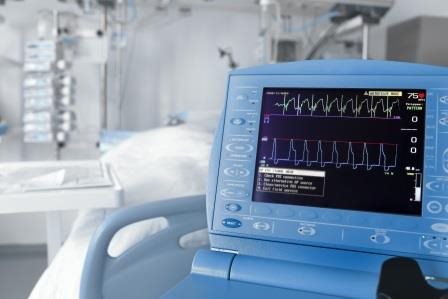SSZTA43 June 2017 ADS1298 , ADS1298R

The electrocardiogram (ECG), which measures electrical signals produced by the heart, has benefited greatly from technological advances. These technological evolutions have resulted in less invasive, more accurate medical procedures and diagnostics and improved patient experiences.
Whereas medical analog front ends (AFEs) were once implemented using discrete components, technological advances enabled manufacturers to integrate most of these components into a single device, making designs simpler and quicker to complete. One of the biggest challenges to designing high-quality ECG systems is acquiring quick and accurate measurements. Portable ECG equipment in consumer and ambulatory applications requires minimal solution size and power consumption, adding to the challenge.
The main function of an AFE is to take electrical signals from the real world and digitize them. However, ECG measurements require several key features that are often designed discretely. Devices that provide a highly integrated solution for a medical AFE include several commonly used features for biopotential measurements. In addition, the architecture of delta-sigma analog-to-digital converters (ADCs) use oversampling and noise shaping to offer high signal-to-noise ratio (SNR), which enable measurements of the smallest of ECG signals. The performance specifications of these devices enable you to design system solutions that can help satisfy International Electrotechnical Commission (IEC) and Association for the Advancement of Medical Instrumentation (AAMI) requirements for medical end equipment.
The ADS1298 family, for example integrates several components with the ADC itself, including a reference voltage, a master clock oscillator and programmable gain amplifier. In addition, these devices incorporate many features that are important when designing ECG systems, including:
- Continuous lead-off detection – If an electrode becomes disconnected, the device provides immediate notification. Alternatively, the physician can monitor the contact quality of the electrodes, which may degrade over time.
- Right-leg drive circuitry – A right leg circuit biases a patient’s biopotentials relative to the measurement subsystem and drives the patient’s body with an inverse common-mode signal. The common-mode signal increases the common-mode rejection ratio (CMRR). This feature is crucial to reducing interference from power-line mains.
- Pace detection – Dedicated pace detection amplifiers enable external processing of pacemaker signals.
- Respiration – Devices like the ADS1298R have integrated impedance detection circuitry that enables medical personnel to take respiration measurements.
- Channel flexibility – An integrated daisy-chain feature enables designers to easily chain multiple devices together to design high-channel-count, simultaneously sampling systems with fewer components.
- Wilson’s central terminal – Wilson’s central terminal (WCT) is an average of the electrical potential in the body calculated from the three primary leads. ADS1298 devices include internal buffers and a summing junction to output the WCT voltage. Single-ended precordial electrodes can then use WCT as the reference.
With high levels of integration and features and exceptional device performance, the ADS1298 device family accelerates the development of precision ECG equipment. Just as the ADS1298 family fits into ECG devices, they also fit into many other types of medical equipment, such as electromyographs (EMGs) and fitness wearables. In future blog posts, I’ll delve into how the high level of integration and device performance of the ADS1298 family enables many other different biopotential measurement applications. To get posts like this delivered to your inbox, sign in and subscribe to Analog Wire.
Additional Resources
- Download the ADS1298 data sheet.
- Learn what TI has to offer for your medical design.